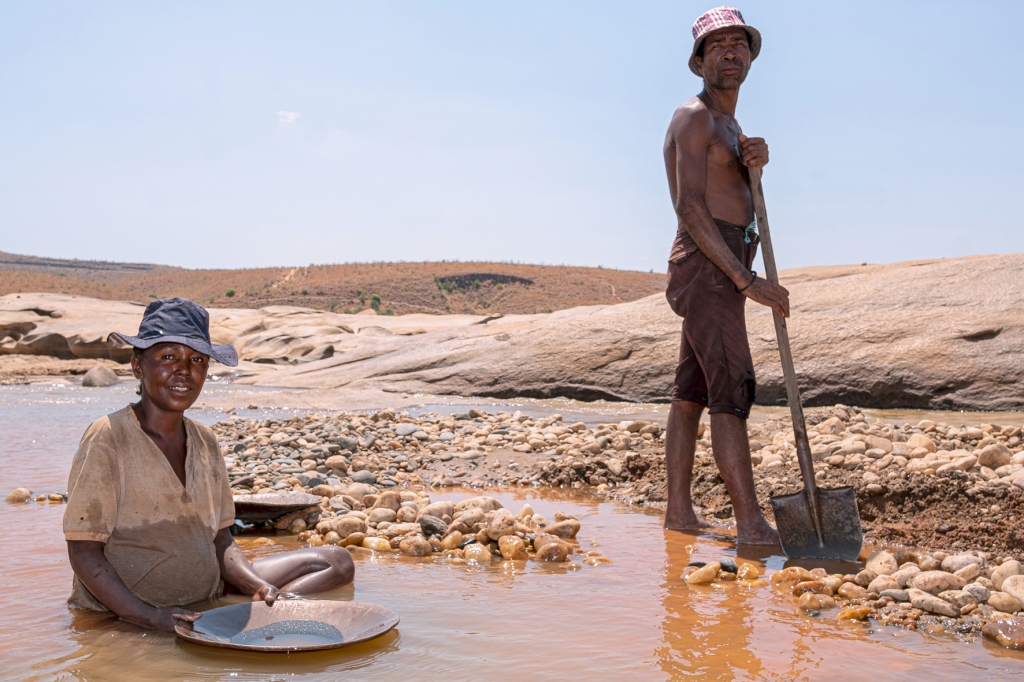Regardless how far you traverse along the Ikopa River, young and old, everybody understands the value of gold.

Gold mining on the Ikopa River dates back to at least the 19th century. The Ikopa is the second longest waterway in Madagascar, its shores produce a considerable share of the country’s gold production. In recent years, artisanal gold mining has become more prevalent on the river, driven in part by the economic opportunities it provides.

River
Artisanal gold mining in Madagascar is a significant contributor to the economy, it is estimated to employ between 750,000 and two million people, however, much of the mining activity is informal and unregulated. The number of people involved in mining on the river vary seasonally, as conditions for mining are influenced by weather patterns and the water level of the river. Still, it is considered a lifeline for many due to the fact that it complements a miner’s main activity and adds a level of resilience to their livelihood.

as a group this season
Rudimentary methods are used to extract gold here, Ikopa miners are either gold panner or rock crusher. Some I am told use mercury amalgamation.

cultivator
A hard job to say the least. Here in the village of Antanimbary the days start early. The fatapera is already in place and well stocked by 4.30, rice will be ready soon. The inhabitants of this village are considered poor, but well off poor, they can afford rice two to three times a day. The shops are well stocked and the speakers business is booming.

and other tools to increase production
Early mornings bring early sun, and since the closest mining site is around 6kms from the village, most of the miners clock in on their pans and shovels by 8.00. The spot of the day is chosen based on first come first served; and those in turn are chosen based on hunch or yesterday’s rumours. The majority are couples or families, others have formed an investment group to buy a pump and the rest are factotum. Everyday, the miners go to the site and are sure that the moment that justifies the months will be today.

Joel’s school and book fees
Midday sun strikes hard out here, shade is far, the last tree was kilometres away. Miners admit trees were removed by miners looking for gold in and under the roots. The river water although visibly dirty is fresh and serves as our drinking source. The river’s current is not to be taken lightly, drownings are often. The miners meantime are focused attacking the river bed. Children and adolescents are a common sight in the water, working equally hard. Some are helping their parents, some have formed their own mining groups. Solofo (36 years), a guest house owner says « kids here can’t read or write even their names, but for calculating gold money they are precise to the Ariary. »

job and hope to be able to afford a decent life for their third child
Hats on, eyes vigilant, muscles tense, hopes high; every splash, every rock crushed, every hammer, every pan seems to be defying the Ikopa rhymes. Lunch break is short, rice or napango saved from the breakfast or a slice of koba or a moof bolle from the nomad sellers and back in the water in search for the biggest gold nugget ever!

panning on the Ikopa

Early afternoon the majority of miners are sun stricken, the regular dips in the water are not enough, for the temperature here easily reaches 35 degrees celsius in October. Fatigue sets fast and the rhythm slows down. Now individuals pay more visits to the pan to evaluate the day’s returns. No one gets more than he deserves, but still everybody eyes the pan of the neighbour. By 17.00hrs the ikopa is deserted except for bathers. Its miners are marching home hearts unmistakably heavier and brighter. For Edie (!?45!? years), a first timer factotum who came on « vacation » as she told her friends in Antananarivo, the daily return of around 10,000ar to 20,000ar (2-4 euros) from this work could barely afford her the equipment, transport and accommodation costs. Her only souvenir to Tana after 10 days of work were some mangos and a bag of coal.


years) sells her day’s findings of 0.04gr of gold for 5,800ar
Stories of kilos of gold from the shores of the Ikopa and wealth beyond belief are common conversations here. Here speculations are plenty and laws aren’t. Gossip mixes up truth and lies, the general insecurity augments fear and stories of sorona (human sacrifice) escalate suspicion, on the golden shores of the Ikopa trust is non-existent.

Back in Antanimbary, the music is loud and the atmosphere is festive. In their huts, Ikopa miners can finally evaluate the day’s earnings and distribute the shares. Gold collectors in the village stay open late, each gram of gold sells for around 160,000ar. For the miners, this is enough to have rice for dinner and breakfast before returning tomorrow to perturb the Ikopa’s waters.
Antanimbary , Madagascar 2019
Copyright ©haddadToni
